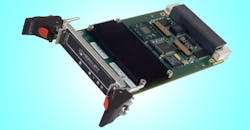Thermal management is a prime requirement for long mean time to failure (MTTF) for any component or system, and the cooling technology developed by Mercury Systems has been found mission-ready (see photo). The company announced that systems using Mercury’s ANSI/VITA 48.7 Air Flow-By standard cooling technology have passed flight tests in multiple manned and unmanned airborne platforms, in the process achieving technology readiness level 8 (TRL-8). Mercury holds a patent on one implementation of the cooling standard (U.S. patent No. 9,389,653 B2), and has revised the licensing arrangement to zero cost to encourage industry-wide adoption of the cooling method.
High-density electronic devices can generate excessive heat in tight spaces, requiring efficient thermal dissipation. The Air Flow-By technology, per the VITA 48.7 cooling standard, provides a significant improvement in thermal management compared to the company’s earlier air-flow-through (AFT) technology. In particular, for heat-generating components such as microprocessors, dissipation of heat is essential to long-term reliability.
The Air Flow-By technology achieves cooling by means of convection heat transfer. It cools both sides of a printed wire board (PWB) by enclosing it in a heat exchanger shell. The sealed environment promotes convection cooling—at the same time protecting against airborne contaminants, electrostatic discharge (ESD), and electromagnetic interference (EMI)—without adding to the board count in the manner of AFT cooling approaches. The zero-cost licensing (by signing a licensing agreement with Mercury) should make the cooling approach even more attractive to developers of ANSI/VITA modules.
About the Author
Jack Browne
Technical Contributor
Jack Browne, Technical Contributor, has worked in technical publishing for over 30 years. He managed the content and production of three technical journals while at the American Institute of Physics, including Medical Physics and the Journal of Vacuum Science & Technology. He has been a Publisher and Editor for Penton Media, started the firm’s Wireless Symposium & Exhibition trade show in 1993, and currently serves as Technical Contributor for that company's Microwaves & RF magazine. Browne, who holds a BS in Mathematics from City College of New York and BA degrees in English and Philosophy from Fordham University, is a member of the IEEE.

